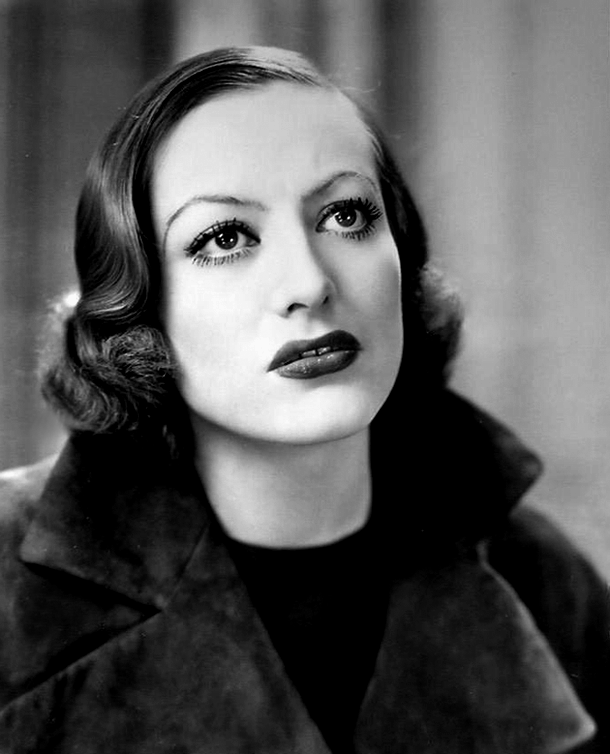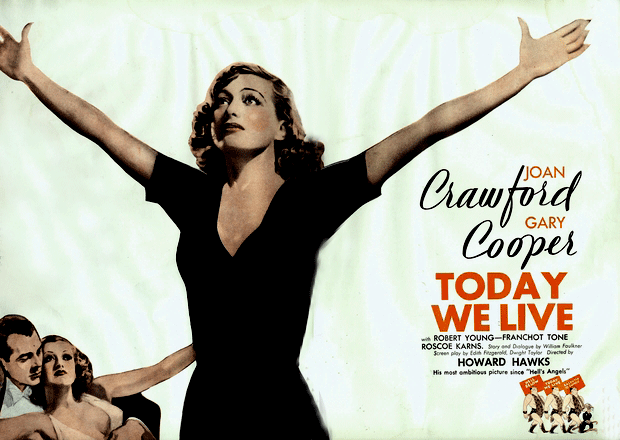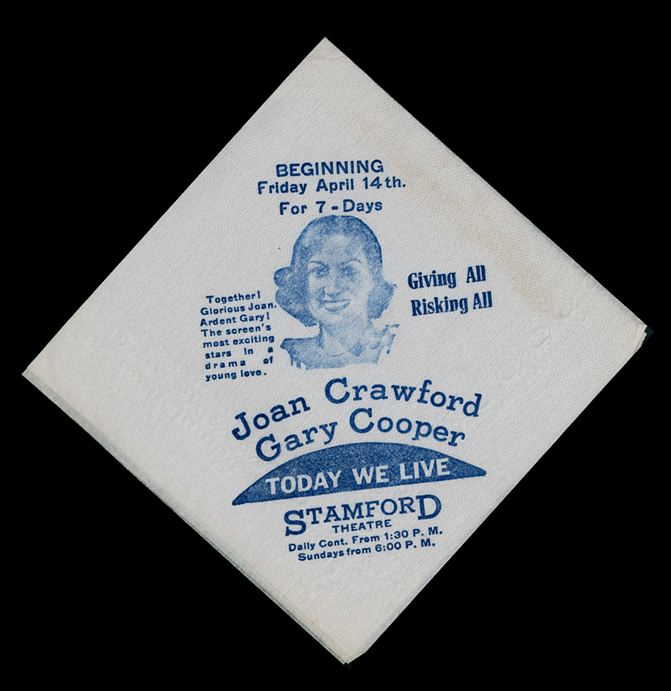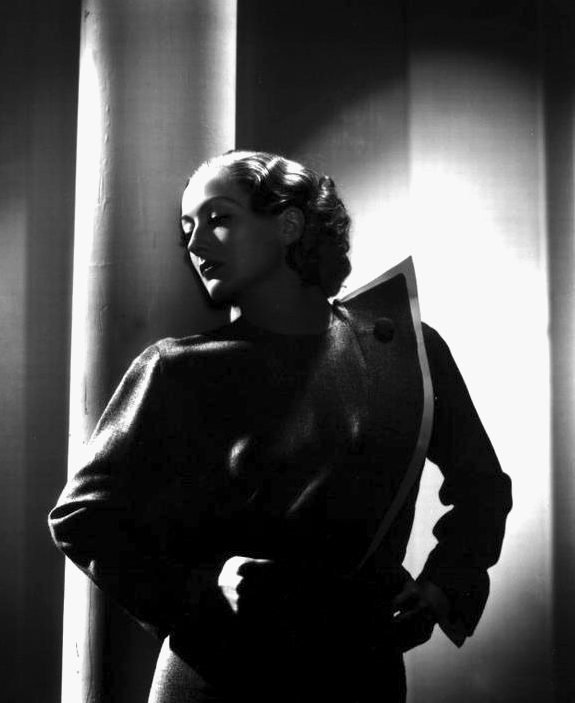|

"I was extremely uncomfortable with a British accent in 'Today We Live'" - Joan Crawford
"Today We Live" 1933
Cast: Joan Crawford (as Diana 'Ann' Boyce-Smith), Gary Cooper, Robert Young, Franchot Tone, Roscoe Karns, Louise Closser Hale,
Rollo Llyod, Hilda Vaughn.
Release date - April 14, 1933 (New York Opening), April 21, 1933 (Nationwide)
Running time - 110, 113 or 115 minutes (11 reels)
Director(s) - Howard Hawks and Richard Rosson (co-director)
Writing Credits - William Faulkner (for the story, Turn About), Edith Fitzgerald and Dwight Taylor.
Producer - Howard Hawks
Cinematographer - Oliver T. Marsh
Costumes - Adrian
Studio - MGM
Production Dates - Began late December of 1932
Working Titles - Turnabout and We Live Again

Movie Synopsis
Richard Bogard (Gary Cooper) arrives in 1916 England and rents an English country house from Diana Boyce-Smith (Joan). When
Diana's (Joan) brother, Lt. Ronnie Boyce-Smith (Franchot Tone) and her fiance, Lt Claude Hope (Robert Young) leave for naval
duty, Richard (Gary Cooper) and Diana (Joan) fall hopelessly in love. As the war intensifies, Richard (Gary Cooper) joins
the flying corps and Diana (Joan) joins the ambulance corps, it is soon after that Diana hears that Richard (Gary Cooper)
has been shot down and killed.
Diana (Joan) ends up marrying Claude (Robert Young), but it is soon learned that Richard (Gary Cooper) is still very much
alive. After several air and sea battles, Ronnie (Franchot Tone) and Claude (Robert Young) are killed bombing a German ship.
The end scene shows Diana (Joan) and Richard (Gary Cooper) paying their respects to the fallen heroes at the family memorial.

Interesting Trivia
The working titles of this film were "We Live Again" and "Turn About." M-G-M borrowed Gary Cooper from
Paramount for the production. "Today We Live" was the first film on which director Howard Hawks and writer William
Faulkner collaborated. A November 1932 "Hollywood Reporter" news item announced that Phillips Holmes was to co-star
with Joan Crawford. Charles "Buddy" Rogers was then announced as a possible co-star in early December 1932.
According to a mid-December HR news item, M-G-M did not begin negotiating for Gary Cooper until two weeks after production
was scheduled to start. These news items conflict with some modern sources, which state that Cooper, Robert Young and Franchot
Tone had been selected by Hawks before Joan Crawford was approached with the script.
According to "International Photographer," photographer Elmer Dyer spent several weeks filming the aerial sequences
for the film at March Field in California. Modern sources note that General Douglas MacArthur reserved the field for the studio's
use. In its review, "Variety" claims that Hawks used footage from Howard Hughes's 1930 production "Hell's Angels"
in this film, in particular the "sequence of the big bomber expedition" and the "main 'dog-fight' and the head-on
collision of two planes." "Daily Vairety" gives a preview running time of 135 minutes, indicating that substantial
footage was deleted before the general release.
Modern sources add the following information about the production: After Faulkner's first six-week contract with M-G-M
ended, Hawks insisted that the studio re-sign the writer and allow the two of them to develop Faulkner's short story "Turn
About" for the screen. In early July 1932, Faulkner wrote a screen treatment of his story, which Hawks then presented
to M-G-M production head Irving Thalberg. Although Thalberg approved the treatment, which was strictly a three-man war drama,
other studio executives insisted that the story be rewritten to accommodate Crawford, whom they needed to put into a new picture
to fulfill a $500,000 contractual obligation. Faulkner complied with the studio's demands and wrote, on instruction from Hawks,
a complete first draft of a screenplay (his first), creating the character of "Ann."
Although Joan Crawford at first resisted being cast in the all-male picture, she finally accepted the assignment and insisted
that Faulkner write her dialogue in the same clipped manner as the male characters'. Faulkner turned in his first draft, which
he signed with both his and Hawks's names, at the end of August 1932. In Faulkner's original draft, "Ronnie," "Ann"
and "Claude" are first presented as children and then are seen as adolescents. Because the child actors who were
to play the threesome could not master British accents, Hawks decided to delete the childhood scenes from the script and hired
Edith Fitzgerald and Dwight Taylor to replace Faulkner, who was in Mississippi, and write a second draft. Fitzgerald and Taylor
then deleted the adolescent scenes and completely rewrote most of the first half of the script. Faulkner was called in later
to revise the final script and added one scene.
Cost: $663K/Domestic Studio Gross: $590K/Foreign Studio Gross: $445K/ LOSS: $23,000
Box Office Receipts: $1,035m.
Inflation Value in 2007: $16,553,391.92.
Photos
Click on images below to see a larger view.
Movie Posters/Lobby Cards etc...
Fan Reviews/Comments
Reviewer, schappe1, says...
Surprisingly exciting drama of World War I featuring some of the best performances of legendary stars Gary Cooper and Joan
Crawford with even better performances by the somewhat less legendary but equally talented Robert Young and Franchot Tone.
The daring-do may seem a bit improbable, (did they really use speed boats to deliver torpedoes in WWI?), but it's certainly
exciting and well-done considering the technology at the time. The only problems is: can't these people talk in complete sentences?
As Robert Osborne just said on TCM, they seem to be reading telegrams to each other. He suggests it was William Faulkner's
attempt to disguise the fact that he had a cast of very American actors playing very British characters. The result is less
British than it is incoherent but the fine cast struggles through, giving the most animated and nuanced performances of their
distinguished careers.

Other Reviews
"Mordaunt Hall" of the New York Times had this to say, "Miss Crawford, although she never impresses one as
being English, gives a steadfast and earnest portrayal..."
Richard Watts, Jr., of the New York Herald Tribune (1933) said, "Visually, "Today We Live" is handsome,
striking and genuinely dramatic, and that is not merely because Miss Crawford is photographed so beautifully...Miss Crawford
is properly effective in her role even if she doesn't seem like someone called Boyce-Smith."
If you have seen this movie, please write a review below. Once your review is submitted, I will post the review below. Thank
you for your review on this film.
Click on the decades below to browse movies.
|

